Every year in Chicago, the media gears up to count the casualties of the Fourth of July, which make headlines across the country. It's a habit that has a long-ago precedent, and one that worked back in the day of reducing casualties.
It seems to have begun around 1899, not surprisingly when the Progressive Era brought civic health to the forefront, when the Trib started to pay close attention to the injuries and deaths wrought by the holiday's imitation of war. With no mild irony, it pointed out that nationwide the "dead on the field of the Fourth of July will outnumber the dead on any battlefield during the Spanish-American war," on July 18, 1899:
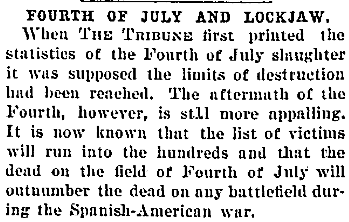
However they came up with that particular calculation, it inaugurated a data-gathering tradition that ran for days after the Fourth each year, and every holiday for years. For instance, on July 6, 1900:
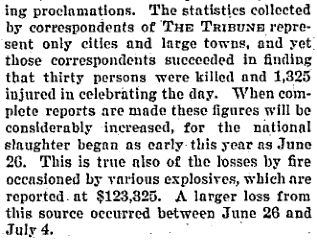
Those statistics—30 killed, 1,325 injured—were nationwide (and as of the 6th, incomplete), gathered from all points and sent back to the mothership. The year before, the Trib counted up five killed in Chicago and nineteen in New York, two weeks after the holiday:
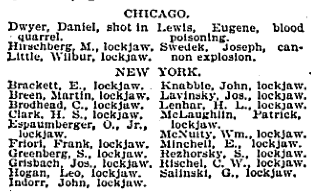
And virtually all of those deaths were from lockjaw, the result of tetanus from fireworks injuries, the vast majority from blank cartridges. This was just as a vaccine was being developed, and long before its widespread use; it was so prevalent that the phenomenon was referred to as "patriotic tetanus."
So the Tribune continued to hammer away at its data journalism project, ratcheting up the rhetoric as it went, as in 1905, when it aggregated all the praise it was receiving for the project (such as this comment from the New York Tribune).
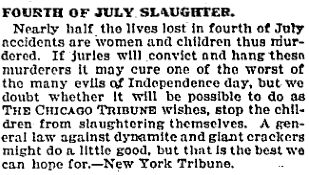
And, eventually, it worked. In 1903, a couple years after the Tribune began its butcher's tally, the Journal of the American Medical Association started its own count. After five years of grisly statistics, JAMA stopped being polite and started getting real, blaming not the victims but local governments for allowing the mayhem, while expanding their data collection to the 84 largest cities in America. Lo and behold, they got action. By 1915, Chicago, Cleveland, Buffalo, Minneapolis, and a few other cities saw drastic reductions in injuries as local officials attempted to rein in firework use.
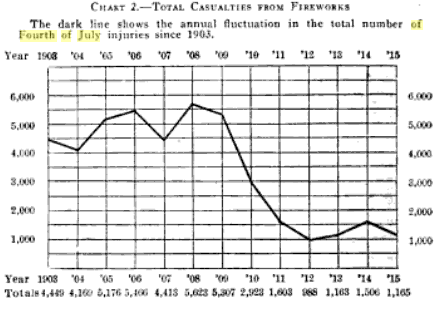
In 1915, looking back on 13 years of laboring on the numbers, the JAMA authors wrote: "Since that time [1908] not only did the press of the country generally take up the cause, but also local, state, and national organizations and societies became interested. They not only argued against the use of fireworks, but, more important, also provided more rational means of celebration. Vigorous action was taken by city councils, and each year the ordinances are growing more prohibitive."
Most impressive was the decline in deaths—from 466 in 1903, when JAMA started counting, to 30 in 1915. A long-ago Chicago newspaper celebrated Chicago's ban on cannons and rockets with a poem, "We'll All Have Both Eyes After the Fourth of July": Nix on the lockjaw / Nix on the maim / Loud noise explosives / Are out of the game. / Fourth of July scares / Have all been excused, / you'll just have to yell / If you're overenthused.



